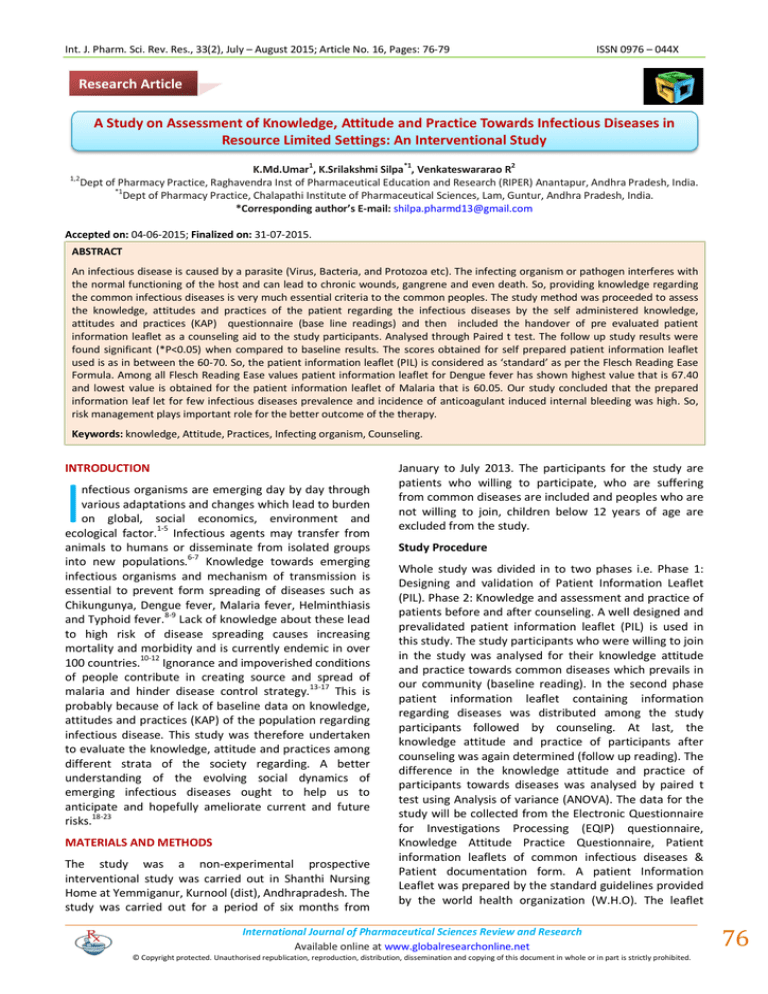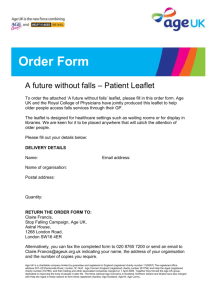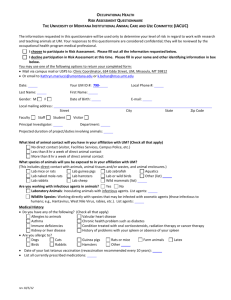Document 13310559
advertisement

Int. J. Pharm. Sci. Rev. Res., 33(2), July – August 2015; Article No. 16, Pages: 76-79 ISSN 0976 – 044X Research Article A Study on Assessment of Knowledge, Attitude and Practice Towards Infectious Diseases in Resource Limited Settings: An Interventional Study 1 1,2 *1 2 K.Md.Umar , K.Srilakshmi Silpa , Venkateswararao R Dept of Pharmacy Practice, Raghavendra Inst of Pharmaceutical Education and Research (RIPER) Anantapur, Andhra Pradesh, India. *1 Dept of Pharmacy Practice, Chalapathi Institute of Pharmaceutical Sciences, Lam, Guntur, Andhra Pradesh, India. *Corresponding author’s E-mail: shilpa.pharmd13@gmail.com Accepted on: 04-06-2015; Finalized on: 31-07-2015. ABSTRACT An infectious disease is caused by a parasite (Virus, Bacteria, and Protozoa etc). The infecting organism or pathogen interferes with the normal functioning of the host and can lead to chronic wounds, gangrene and even death. So, providing knowledge regarding the common infectious diseases is very much essential criteria to the common peoples. The study method was proceeded to assess the knowledge, attitudes and practices of the patient regarding the infectious diseases by the self administered knowledge, attitudes and practices (KAP) questionnaire (base line readings) and then included the handover of pre evaluated patient information leaflet as a counseling aid to the study participants. Analysed through Paired t test. The follow up study results were found significant (*P<0.05) when compared to baseline results. The scores obtained for self prepared patient information leaflet used is as in between the 60-70. So, the patient information leaflet (PIL) is considered as ‘standard’ as per the Flesch Reading Ease Formula. Among all Flesch Reading Ease values patient information leaflet for Dengue fever has shown highest value that is 67.40 and lowest value is obtained for the patient information leaflet of Malaria that is 60.05. Our study concluded that the prepared information leaf let for few infectious diseases prevalence and incidence of anticoagulant induced internal bleeding was high. So, risk management plays important role for the better outcome of the therapy. Keywords: knowledge, Attitude, Practices, Infecting organism, Counseling. INTRODUCTION I nfectious organisms are emerging day by day through various adaptations and changes which lead to burden on global, social economics, environment and ecological factor.1-5 Infectious agents may transfer from animals to humans or disseminate from isolated groups into new populations.6-7 Knowledge towards emerging infectious organisms and mechanism of transmission is essential to prevent form spreading of diseases such as Chikungunya, Dengue fever, Malaria fever, Helminthiasis and Typhoid fever.8-9 Lack of knowledge about these lead to high risk of disease spreading causes increasing mortality and morbidity and is currently endemic in over 100 countries.10-12 Ignorance and impoverished conditions of people contribute in creating source and spread of malaria and hinder disease control strategy.13-17 This is probably because of lack of baseline data on knowledge, attitudes and practices (KAP) of the population regarding infectious disease. This study was therefore undertaken to evaluate the knowledge, attitude and practices among different strata of the society regarding. A better understanding of the evolving social dynamics of emerging infectious diseases ought to help us to anticipate and hopefully ameliorate current and future 18-23 risks. MATERIALS AND METHODS The study was a non-experimental prospective interventional study was carried out in Shanthi Nursing Home at Yemmiganur, Kurnool (dist), Andhrapradesh. The study was carried out for a period of six months from January to July 2013. The participants for the study are patients who willing to participate, who are suffering from common diseases are included and peoples who are not willing to join, children below 12 years of age are excluded from the study. Study Procedure Whole study was divided in to two phases i.e. Phase 1: Designing and validation of Patient Information Leaflet (PIL). Phase 2: Knowledge and assessment and practice of patients before and after counseling. A well designed and prevalidated patient information leaflet (PIL) is used in this study. The study participants who were willing to join in the study was analysed for their knowledge attitude and practice towards common diseases which prevails in our community (baseline reading). In the second phase patient information leaflet containing information regarding diseases was distributed among the study participants followed by counseling. At last, the knowledge attitude and practice of participants after counseling was again determined (follow up reading). The difference in the knowledge attitude and practice of participants towards diseases was analysed by paired t test using Analysis of variance (ANOVA). The data for the study will be collected from the Electronic Questionnaire for Investigations Processing (EQIP) questionnaire, Knowledge Attitude Practice Questionnaire, Patient information leaflets of common infectious diseases & Patient documentation form. A patient Information Leaflet was prepared by the standard guidelines provided by the world health organization (W.H.O). The leaflet International Journal of Pharmaceutical Sciences Review and Research Available online at www.globalresearchonline.net © Copyright protected. Unauthorised republication, reproduction, distribution, dissemination and copying of this document in whole or in part is strictly prohibited. 76 © Copyright pro Int. J. Pharm. Sci. Rev. Res., 33(2), July – August 2015; Article No. 16, Pages: 76-79 contains information about signs and symptoms, prevention and control of diseases like Chikungunya, Dengue fever, Malaria, Helminthiais and Typhoid. Measuring Knowledge Attitude &Practice Participants Knowledge of common diseases and its symptoms, prevention and control was assessed using Knowledge, Attitude & Practice (self KAP Questionnaire), administered at baseline and then at the end of the study (follow up readings) to evaluate the impact of counseling on patients Knowledge, Attitude & Practice (KAP) towards infectious diseases. Follow up Participants were counseled for second time either through direct questionnaire at the time of second visit to questioning at the time of second visit to physician or through phone. Participants who were included in the study were given patient counseling for regarding the infectious diseases and also given the prepared patient information leaflet form to those in our study. At last, the knowledge, attitude and practice of participants after counseling shall be determined again (follow up reading). Patient Education The basics of infectious diseases were dealt with what are the signs and symptoms, prevention and control of the diseases like Chikungunya, Dengue fever, Helminthiasis, Malaria and Typhoid. The importance of patient counseling and Patient Information Leaflet (PIL) was also discussed. RESULTS AND DISCUSSION Flesch-Kincaid grade level formula EQIP Quitionnarie evaluation PMOSE/IKIRSCH formula Above all methods we use to evaluate PIL by FRE formula and EQIP questionnaire evaluation. Evaluation of Patient Information Leaflet (PIL) by Flesch Reading Ease Formula Flesch Reading Ease Formula is considered as one of the oldest and most accurate readability formulas .The score between 60 and 70 is largely considered acceptable, the following table is also helpful to assess the ease of readability document: 90-100: Very Easy 80-89 : Easy 70-79 : Fairly Easy 60-69 : Standard 50-59 : Fairly Difficult 30-49 : Difficult Formula F.R.E=206.835-(1.015×ASL) - (84.6×ASW) Where, ASL=Average sentences length (no. of words/no. of sentences) ASW=average no. of syllables per word (no. of syllables/no. of words) Table 1: Different types of infectious diseases with their Flesch Reading Ease (F.R.E) values S. No Evaluation of patient information leaflet Patient information leaflet (PIL) was prepared in two parts Signs and symptoms and prevention and control as per the standard guidelines of WHO and tested for quality by Electronic Questionnaire for Investigations Processing (ensuring quality information for patients) method and by the Flesch Readability formula and interpretation of data was done for individual criterion and for different group of respondents FRE readability scale was used for estimation readability and complexity of PIL. High response score indicates better quality and low response score indicates poor quality. There are different methods to evaluate Patient information leaflet, they are: Flesch Reading Ease(FRE) formula Spache grade level score SMOG formula 0-29 : Very Confusing The course of patient education for the study participants was designed as follows during their visit patients were asked what they knew about particular type of disease provided the patient information leaflets. Their benefits were then reinforced or corrected. Fog formula ISSN 0976 – 044X Name of the Disease F.R.E values 1 Chikungunya 61.16 2 Dengue fever 67.4 3 Malaria 60.05 4 Typhoid 60.15 5 Helminthiasis 62.82 The scores obtained for self prepared PIL used is as in between the 60-70. So, the PIL is considered as ‘standard’ as per the FRE formula. Among all F.R.E values PL for Dengue fever has shown highest value that is 67.40 and lowest value is obtained for the PIL of Malaria that is 60.05. Evaluation of Patient information leaflet (PIL) by EQIP questionnaire Evaluation of patient information leaflet is an important in ensuring the conveying of information to the people. So, Patient information leaflets (PIL) require evaluation to International Journal of Pharmaceutical Sciences Review and Research Available online at www.globalresearchonline.net © Copyright protected. Unauthorised republication, reproduction, distribution, dissemination and copying of this document in whole or in part is strictly prohibited. 77 © Copyright pro Int. J. Pharm. Sci. Rev. Res., 33(2), July – August 2015; Article No. 16, Pages: 76-79 ensure its quality. The quality of such patient education material needs to be evaluated by the patients. infectious diseases which have high prevalence rates around the region; those are Chikungunya, Dengue, Malaria, Typhoid and Helminthiasis. Firstly we prepared a patient information leaflet bearing the information regarding the above mentioned diseases which included the signs, symptoms and prevention of each disease. Patient information leaflet was prepared by using standard WHO guidelines. In our study we have included Trainee pharmacists, Pharmacy students, Social workers, Teachers, Medical representatives, diseased patients, Nurses, Registered Pharmacists. Table 1: explain the number and % of participants involved. The highest percentages of participants are pharmacy students. The prepared Patient information leaflet (PIL) was evaluated by two methods as explained below, and it was translated in to local language “Telugu” by the experts and it was again retranslated to English for validation. The prepared information leaflet was evaluated by evaluating tools like Electronic Questionnaire for Investigations Processing (EQIP) questionnaire and Flesch Ease Readability formula. For evaluation of PIL using EQIP questionnaire we have selected a total of 104 study participants who were trainee Pharmacists, Pharmacy students, Social workers, Pharmacy Teachers, Medical representatives, Diseased patients, Nurses and Registered Pharmacists in and around Yemmiganur, Kurnool (dist), Andhra Pradesh. Diseases are as common to human beings as health on this planet, though the proper etiopathogenesis of various life threatening diseases is known or unknown the diseases shall be either neglected or ignored because of lack of knowledge and attitude in the practice of prevention of diseases. So, we have planned to give awareness to common public regarding some infectious diseases and provide the knowledge, attitude and practice to prevent the diseases. The signs and symptoms for different diseases were explained and also give the proper knowledge for prevention by providing patient information leaflet followed by patient counseling. In our study we have selected five different types of KAP questionnaire ISSN 0976 – 044X Age distribution Gender distribution S. No KAP Baseline KAP Final follow up 1. 47 81 Adolescents 2. 56 85 Adult 3. 79 100 Geriatrics 15.0 4. 75 106 5. 97 112 6. 87 105 Status Percentage Disease Percentage Percentage 7. 92 104 <50,000/yr 38.5 Chikungunya 17.5 27.24 8. 133 111 50-1,00,000/yr 46.5 Dengue fever 29.0 74.13 9. 146 116 >1,00,000/yr 15.0 Malaria 26.0 27.58 10. 62 76 Typhoid 20.5 79.31 11. 45 69 Helminthiasis 7.0 9.65 12. 107 106 13. 90 103 Drugs Percentage Status Percentage 14. 94 94 Antipyretics 27.24 Smoking 21.5 15. 52 69 NSAIDs 74.13 Alcohol 10.5 16. 58 76 Antibiotics 27.58 Other drugs 8.5 17. 118 112 Analgesics 79.31 Nil 64.79 PPIs 9.65 Anti histamines 8.27 Qinine & Quinalones 11.89 Age (yr) Percentage Percentage 39.5 Male 64.5 21.5 45.5 Female 35.5 10.5 Economical status 8.5 Disease distribution Drug distribution For the evaluation of Knowledge, Attitude and Practice we has selected total of 200 participants to assess the knowledge, attitude and practice towards infectious diseases. We have used the prepared and pre-evaluated prepared Patient information leaflet (PIL) for our study. In the first visit, we had collected all the details of patients (like Percentage Gender Social history 64.79 8.27 11.89 demographic details, socio economical status, drug usage, present and past medical history) by reviewing the medication chart. The participants was then asked to answer the prepared Knowledge, Attitude and Practice questionnaire, from whom prior inform consent was taken and scored accordingly (Base line reading). In the follow up visit, 67 International Journal of Pharmaceutical Sciences Review and Research Available online at www.globalresearchonline.net © Copyright protected. Unauthorised republication, reproduction, distribution, dissemination and copying of this document in whole or in part is strictly prohibited. 78 © Copyright pro Int. J. Pharm. Sci. Rev. Res., 33(2), July – August 2015; Article No. 16, Pages: 76-79 participants were missed out of 200. The available participants were questioned again using the same questionnaire and scored accordingly (Follow up reading). The differences in the knowledge, attitude and practice of participants towards diseases shall be analysed through Paired t test (using Analysis of variance) with significance respectively P*<0.05 significant, P**<0.01 highly significant, P***<0.001 very highly significant. The follow up study results were found significant when compared to baseline results. CONCLUSION 9. ISSN 0976 – 044X Morse SS. Emerging viruses: defining the rules for viral traffic. Perspect Biol Med, 34, 1991, 387-409. 10. Morse SS. Regulating viral traffic. Issues Sci Technol, 7, 1990, 81-4. Morse SS. Emerging viruses: defining the rules for viral traffic. Perspect Biol Med, 34, 1991, 387-409. 11. M.L. Moro, C. Gagliotti, G. Silvi. Knowledge, attitudes and practices survey after an outbreak of chikungunya infections. International Health. 2010, 223–227. 12. Jocelyn Raude, Michel Setbon. The role of environmental and individual factors in the social epidemiology of chikungunya disease on Mayotte Island. Health & Place. 2009, 689–699. We have carried out a study on “Assessment of Knowledge, Assessment and Practice of common population towards infectious diseases in resource limited settings: An interventional study”. 13. Guzmán MG, Kourí G. Dengue: an update. Lancet Infect Dis, 2, 2002, 33-42. Our study concluded that the prepared information leaf let for few infectious diseases prevalence and incidence of anticoagulant induced internal bleeding was high. 15. World Health Organization. Geographical distribution of arthropod-borne diseases and their principal vectors. Geneva: World Health Organization (WHO/VBC/89.967), 1989, 138-148. So, risk management plays important role for the better outcome of the therapy. To confirm this study many more studies different geographical regions with large population is needed. REFERENCES 1. Kate E. Jones, Nikkita G. Patel, Marc A. Levy, Adam Storeygard, Deborah Balk, John L. Gittleman. Global trends in emerging infectious diseases. Nature, 2008, 990-993. 2. Wilson ME, Levins R, Spielman A. Disease in evolution: global changes and emergence of infectious diseases. New York: New York Academy of Sciences, 1994, 740. 3. B. Anil Kumar, K. V. Phani Madhavi. Knowledge and practice regarding vector borne diseases among urban slum dwellers of Guntur district, Andhra Pradesh. Journal of Evolution of Medical and Dental Sciences, 2013, 47564762. 4. Chanthalay Sayavong, Jiraporn Chompikul, Somsak Wongsawass, Cheerwit Rattanapan. Knowledge, attitudes and preventive behaviors related to dengue vector breeding control measures among adults in communities of Vientiane, capital of the Lao PDR. journal of infectious and public health. 2015. 5. Naing C., Ren W., Man C., Fern K., Qiqi C., Ning C. Awareness of dengue and practice of dengue control among the semi-urban community: a cross sectional survey. J Community Health. 2011, 1044–1049. 6. Levins R, Awerbuch T, Brinkmann U. The emergence of new diseases. American Scientist, 1994, 52-60. 7. Morse SS, Schluederberg A. Emerging viruses: the evolution of viruses and viral diseases. J Infect Dis, 162, 1990, 1-7. 8. Morse SS. Examining the origins of emerging viruses. In: Morse SS, ed. Emerging viruses. New York: Oxford University Press, 1993, 10-28. 14. Ahsan T. Dengue fever: a regular epidemic? J Pak Med Assoc, 58, 2008, 1-2. 16. Wesson AF. Human ecology and malaria. Am J Trop Med Hyg, 1972, 658–662. 17. EQIP: Ensuring Quality Information for Patients, Patient Information Group, Great Ormond Street Hospital, Version 11, Dec 2003. 18. Nitin Joseph, Maria Nelliyanil, Shashidhar M Kotian, Mohammed Omar, R. Srikanth Aswin, Saiteja Donkena. Awareness, practices and expenditure towards mosquito bite prevention methods in urban and semi-urban areas of South India. International Journal of Mosquito Research, 2015, 53-59. 19. Khaled G. Saieda, Abdullah Al-Taiarb, Abdulrahman Altairea, Ala Alqadsia. Knowledge, attitude and preventive practices regarding dengue fever in rural areas of Yemen. Int. Health, 2015, 213-325. 20. Meghnath Dhimal, Krishna Kumar Aryal, Mandira Lamichhane Dhimal, Ishan Gautam. Knowledge, Attitude and Practice Regarding Dengue Fever among the Healthy Population of Highland and Lowland Communities in Central Nepal. Plos one, 9(7), 2014. 21. Winch P., Leontsini E., Rigau-Perez J., Ruiz-Perez M., Clark G., Gubler D. Community-based dengue prevention programs in Puerto Rico: impact on knowledge, behavior, and residential mosquito infestation. Am J Trop Med Hyg. 2002, 363–370. 22. Dike N., Onwujekwe O., Ojukwu J., Ikeme A., Uzochukwu B., Shu E. Influence of education and knowledge on perceptions and practices to control malaria in Southern Nigeria. Soc Sci Med. 2006, 103–106. 23. WHO/TDR (2009) Dengue: guidelines for diagnosis, treatment, prevention and control. Geneva: World Health Organization (WHO) and the Special Programme for Research and Training in Tropical Diseases (TDR). Source of Support: Nil, Conflict of Interest: None. International Journal of Pharmaceutical Sciences Review and Research Available online at www.globalresearchonline.net © Copyright protected. Unauthorised republication, reproduction, distribution, dissemination and copying of this document in whole or in part is strictly prohibited. 79 © Copyright pro

